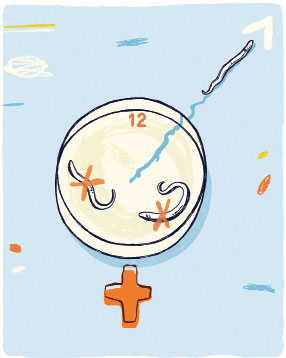SPRING 2014 CONTENTS
Home
Fresh starts for hearts
Cardiovascular medicine looks to stem cells for answers
Hiding in plain sight
A high-cholesterol gene
A change of heart
A conversation with Dick Cheney
Switching course
Untangling a birth defect decades later
Dear Dr. Shumway
A boy, two frogs and an airmail letter
Easy does it
Aortic valve replacement without open-heart surgery gains ground

DOWNLOAD PRINTABLE
ISSUE (PDF)

Gutted
Brian Cairns
A new study by researchers at the School of Medicine could help pinpoint ways to counter the effects of the antibiotics-driven depletion of friendly, gut-dwelling bacteria.
We have difficulty living without the thousands of distinct bacterial strains that inhabit our gut, says Justin Sonnenburg, PhD, assistant professor of microbiology and immunology and the senior author of the Nature study. They make vitamins, provide critical training to our immune systems and even guide our tissues’ development. Antibiotics decimate this gut-microbe ecosystem, which may take a month or more to regain its numbers and appears to suffer the permanent loss of some constituent bacterial strains.
It is thought that our commensal, or friendly, bacteria serve as a kind of lawn that, in commandeering the rich fertilizer that courses through our gut, outcompetes the less-well-behaved pathogenic “weeds.” It has also been suggested that our commensal bugs secrete pathogen-killing factors. Another theory holds that the disruption of our inner microbial ecosystem somehow impairs our immune responsiveness.
“Our work specifically supports the suggestion that our resident microbes hold pathogens at bay by competing for nutrients,” Sonnenburg says. “Antibiotics open the door for pathogens to take hold.” In the first 24 hours after administration of oral antibiotics, a spike in carbohydrate availability takes place in the gut, the study shows. This nutrient surplus, combined with the reduction of friendly bacteria due to antibiotics, permits potentially deadly pathogens to get a toehold.
Sonnenburg says he thinks researchers may be able to find drugs or probiotics that, co-administered with antibiotics, could inhibit the carbohydrate spike. —Bruce Goldman
Bleach of promise
It’s like a mini spa. Mice enjoying frequent dips in a lukewarm, dilute bleach solution emerge not only fluffy and squeaky clean, but also (after two weeks of daily treatment) with thicker, more-elastic skin on their bellies.
Dermatologist Thomas Leung, MD, PhD, has learned that the simple treatment impedes processes that age and damage skin cells by blocking the activity of a protein called NF-kB. The finding, published in the Journal of Clinical Investigation, suggests similar baths might help human patients repair damage from radiation therapy or excess sun exposure. — Krista Conger
Caribbean genes
Slavery, colonization and immigration. The Caribbean has been a busy place for the past several hundred (and thousands) of years. Geneticists Andres Moreno-Estrada, MD, PhD, and Carlos Bustamante, PhD, recently dove into this melting pot in an attempt to discern exactly how much of human history remains stored in the modern-day genes.
The answer? More than you might think.
The researchers compared genetic variants in 251 people of Caribbean descent with those in more than 3,000 non-Caribbeans. Using a new way of analyzing DNA to infer genetic ancestry at a fine geographic scale, they identified an influx of European genes within a generation of Columbus’ arrival, as well as two geographically distinct pulses of African immigration corresponding to the transatlantic slave trade.
Their study in PLOS Genetics explains why populations sometimes classified by medical researchers as a single group instead display marked differences among populations in susceptibility to diseases or responses to therapeutic drugs.
“If we don’t understand the origin of our genetic variants,” says Moreno-Estrada, “we won’t be able to design personalized, or even population-level, medicine.”—Krista Conger
Liver lode
In a feat of modern-day alchemy with huge potential for regenerative medicine, Gary Peltz, MD, PhD, and his colleagues have developed a fast, efficient way to turn cells extracted from routine liposuction into liver cells.
Using mice’s bodies as a living laboratory, the scientists converted adipose (fat) stem cells they’d harvested from human liposuction extracts into liver-like cells that flourished. Similar methods of creating liver cells exist, but they rely on other types of stem cells and require introducing foreign and potentially carcinogenic genes.
All aspects of the new fat-to-liver technique are adaptable for human use, says Peltz, who is a professor of anesthesia. The new process takes nine days from start to finish — fast enough to regenerate liver tissue in acute liver poisoning victims, who would otherwise die within a few weeks, barring liver transplantation. ”—Bruce Goldman
In the nose
Brian Cairns
David Relman, MD, professor of medicine and of microbiology and immunology, and his colleagues have revealed that formerly overlooked sites deep inside the nose can be reservoirs for Staphylococcus aureus, a major bacterial cause of disease.
About one-third of us persistently, and another third occasionally, carry S. aureus on our skin and in our noses. The vast majority of the time the microbe does little or no harm. But a wound, a medical incision or catheter placement can let S. aureus get into the bloodstream, potentially causing serious and even life-threatening problems such as sepsis, pneumonia or infection of heart valves. Not so good if you’re in, say, an ICU.
Rigorous regimens for ridding people’s skin and noses of S. aureus exist, but typically the bug bounces back before long. The new study in Cell Host & Microbe may explain why.
Using special instruments to guide tiny swabs to three precise locations within 12 healthy subjects’ noses, Relman’s team found that if S. aureus was present at the outermost site — where most attempts to rid the nose of the bug are focused — it was probably present at the other two, harder-to-reach sites.
An implication: Treating only the most easily accessible site won’t banish the bugs. It’s reminiscent of the proverbial drunk looking for his car keys under the lamppost, because it’s easier to see there. — Bruce Goldman
Ladykillers
Brian Cairns
Women, if you’ve ever thought the men in your life were trying to kill you, you could be right. That is, if you’re a roundworm.
For a few years, it’s been known that the mere presence of males of certain species of flies and worms can shorten the life span of their female or, in the case of some roundworms, hermaphroditic counterparts by as much as a third. But it hasn’t been clear why. Some researchers theorize that the physical stress of mating causes early death.
Stanford geneticist Anne Brunet, PhD, suggests something more than sex is to blame — specifically, that the males are carrying out a calculated plan at the molecular level to off the baby-makers after they’ve done their jobs. This “male-induced demise” could conserve precious resources for a male’s offspring or decrease the supply of mates for other males.
Brunet’s research, published in Science Express, shows that males secrete signaling molecules that initiate the killing process across distances. But as tempting as it is to extend the findings to mammals and — dare we say it? — humans, this strategy would likely backfire in situations where mothers are needed to rear the young.
“In worms, once the male has mated and eggs are produced, the mother can be discarded,” Brunet says. “She is not needed to care for the baby worms. Why should she be allowed to stay around and eat?” — Krista Conger
Down insight
Is Down syndrome a stem-cell-associated disease? Recent research published in Nature by cancer biologist and stem cell expert Michael Clarke, MD, suggests that it could be — at least in part.
He and Craig Garner, PhD, the co-director of Stanford’s Center for Research and Treatment of Down Syndrome, found that mouse and human stem cells from throughout the body struggle to grow and self-renew when they have an extra copy of chromosome 21 (the triplication of this chromosome is the cause of the condition). But blocking the expression of just one gene, called Usp16, on the chromosome helps the cells function more normally.
The findings suggest answers to many long-standing mysteries about the condition, including why people with Down syndrome appear to age faster and often exhibit early Alzheimer’s disease. It could be because their stem cell pools are exhausted too quickly during development. Blocking this expression might alleviate some of the cognitive difficulties associated with the condition.
“There appear to be defects in the stem cells in all the tissues that we tested, including the brain,” says Clarke. “We believe Usp16 overexpression is a major contributor to the neurological deficits seen in Down syndrome.” — Krista Conger
It’s all in the translation
A Stanford center focused on accelerating the translation of medical research from bench to bedside will receive $45.3 million over four and a half years from the National Institutes of Health.
The Stanford Center for Clinical and Translational Research and Education, also known as Spectrum, is among 15 institutions to receive Clinical and Translational Science Awards from the NIH. Spectrum earned the top peer-review score on its proposal for the new funding.
“The award is a strong vote of confidence for our work in translational discovery,” says Lloyd Minor, MD, dean of the School of Medicine.
Spectrum’s director, Harry Greenberg, MD, says the funding helps address one of the nation’s biggest challenges: providing better, safer and less costly health care for all. — Kris Newby


